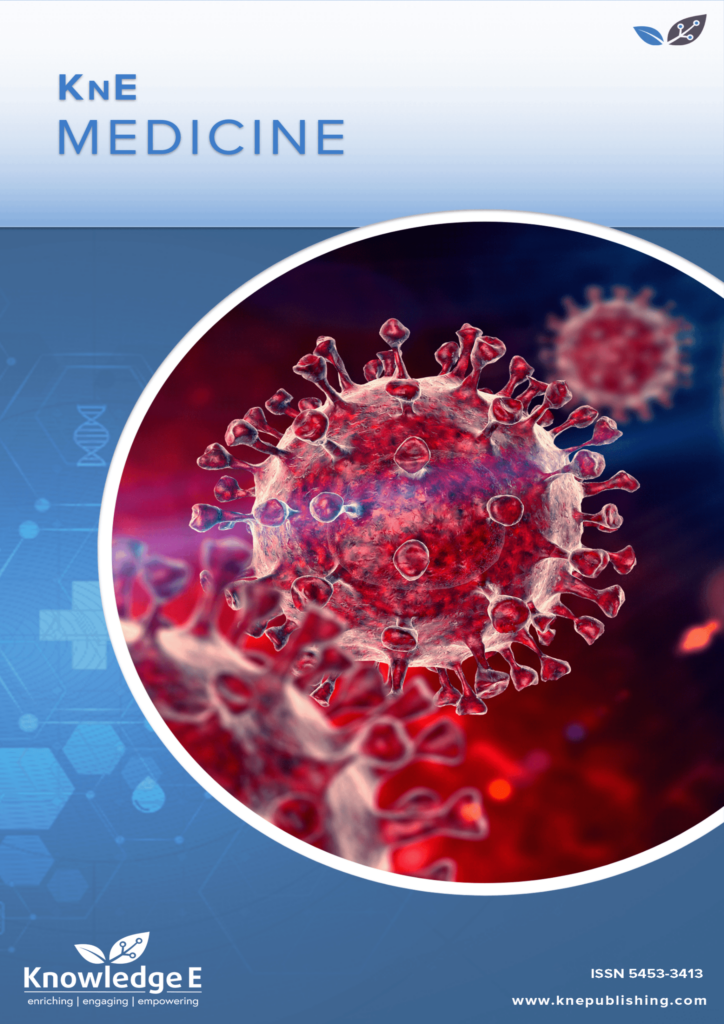
KnE Medicine
ISSN: 2519-125X
The latest conference proceedings on all fields of medicine.
Differences in Folate and Vitamin B12 Serum Levels Between Mothers Whose Children were Diagnosed with Non-syndromic Cleft Lip and Cleft Lip with Palate
Published date: Mar 08 2023
Journal Title: KnE Medicine
Issue title: 2nd International Conference on Medical Health Science (2nd ICMEDH)
Pages: 91–98
Authors:
Abstract:
Non-syndromic (NS) cleft lip (CL) and cleft lip with palate (CLP) are abnormalities in the orofacial area that are not accompanied by abnormalities in the head and neck and have normal physical growth and cognitive development. Cleft lip and CLP are caused by two factors, genetic and environmental factors which include deficiencies of micronutrients such as folate and vitamin B12. This study aimed to determine the differences in folate and vitamin B12 serum levels between mothers whose children were diagnosed with NS CL and CLP. An analytical observational study was conducted on folate and vitamin B12 serum levels from 44 mothers whose children were diagnosed with NS CL and CLP. Data were analyzed by t-test for folate serum levels and Mann Whitney for vitamin B12 serum levels. All mothers whose children were diagnosed with non-syndromic CL and CLP, respectively, had normal serum folate levels. Meanwhile, most of the mothers suffered from vitamin B12 deficiency, both mothers whose children were diagnosed with CL (91.6%) and mothers whose children were diagnosed with CLP (93.75%). The mean folate serum level between CL was slightly higher than CLP (p-value = 0.711) but showed no statistical difference in folate levels in the two groups. The median B12 levels between CLP were slightly higher (p-value = 0.394), which indicated that the B12 levels between the two groups were not statistically significant. There were no differences in folate and vitamin B12 serum levels between mothers whose children were diagnosed with non-syndromic cleft lip and cleft lip with palate.
Keywords: Folate, B12, CL, CLP
References:
[1] Stuppia L, Capogreco M, Marzo G, La Rovere D, Antonucci I, Gatta V, et al. Genetics of syndromic and nonsyndromic cleft lip and palate. J Craniofac Surg. 2011 Sep;22(5):1722–6.
[2] Mitchell ES, Conus N, Kaput J. B vitamin polymorphisms and behavior: evidence of associations with neurodevelopment, depression, schizophrenia, bipolar disorder and cognitive decline. Neurosci Biobehav Rev. 2014 Nov;47:307–20.
[3] Dixon MJ, Marazita ML, Beaty TH, Murray JC. Cleft lip and palate: understanding genetic and environmental influences. Nat Rev Genet. 2011 Mar;12(3):167–78.
[4] Kunjana T, Zuliyanto A. Studi Komparatif Kejadian Celah Orofasial Menurut Tingkat Konsumsi Suplemen Asam Folat. Sainteks. 2019;14(2).
[5] van Rooij IA, Vermeij-Keers C, Kluijtmans LA, Ocké MC, Zielhuis GA, Goorhuis- Brouwer SM, et al. Does the interaction between maternal folate intake and the methylenetetrahydrofolate reductase polymorphisms affect the risk of cleft lip with or without cleft palate? Am J Epidemiol. 2003 Apr;157(7):583–91.
[6] Blanco R, Colombo A, Pardo R, Suazo J. Maternal biomarkers of methylation status and non-syndromic orofacial cleft risk: a meta-analysis. Int J Oral Maxillofac Implants. 2016 Nov;45(11):1323–32.
[7] Angulo-Castro E, Acosta-Alfaro LF, Guadron-Llanos AM, Canizalez-Román A, Gonzalez-Ibarra F, Osuna-Ramírez I, et al. Maternal risk factors associated with the development of cleft lip and cleft palate in Mexico: A case-control study. Iran J Otorhinolaryngol. 2017 Jul;29(93):189–95.
[8] Jamilian A, Sarkarat F, Jafari M, Neshandar M, Amini E, Khosravi S, et al. Family history and risk factors for cleft lip and palate patients and their associated anomalies. Stomatologija. 2017;19(3):78–83.
[9] Kumari P, Ali A, Sukla KK, Singh SK, Raman R. Lower incidence of nonsyndromic cleft lip with or without cleft palate in females: is homocysteine a factor? J Biosci. 2013 Mar;38(1):21–6.
[10] Finkelstein JL, Fothergill A, Johnson CB, Guetterman HM, Bose B, Jabbar S, et al. Anemia and Vitamin B-12 and Folate Status in Women of Reproductive Age in Southern India: Estimating Population-Based Risk of Neural Tube Defects. Curr Dev Nutr. 2021 Apr;5(5):nzab069. https://doi.org/10.1093/cdn/nzab069.
[11] Tettamanti L, Avantaggiato A, Nardone M, Palmieri A, Tagliabue A. New insights in orofacial cleft: epidemiological and genetic studies on italian samples. Oral Implantol (Rome). 2017 Apr;10(1):11–9.
[12] Munger RG, Kuppuswamy R, Murthy J, Balakrishnan K, Thangavel G, Sambandam S, et al. Maternal vitamin B12 status and risk of cleft lip and cleft palate birth defects in Tamil Nadu state, India. Cleft Palate Craniofac J. 2021 May;58(5):567–76.
[13] Chattopadhyay D, Vathulya M, Naithani M, Jayaprakash PA, Palepu S, Bandyopadhyay A, et al. Frequency of anemia and micronutrient deficiency among children with cleft lip and palate: a single-center cross-sectional study from Uttarakhand, India. Arch Craniofac Surg. 2021 Feb;22(1):33–7.
[14] Warubania SA, Triyani Y, Bhatara T, Widjajanegara H. Gambaran Faktor Risiko Maternal pada Kehamilan Trimester Pertama dan Jenis Celah Orofacial di YPPBL tahun 2017. Prosiding Pendidikan Dokter; 2018. pp. 601–6.
[15] Wallenstein MB, Shaw GM, Yang W, Carmichael SL. Periconceptional nutrient intakes and risks of orofacial clefts in California. Pediatr Res. 2013 Oct;74(4):457–65.